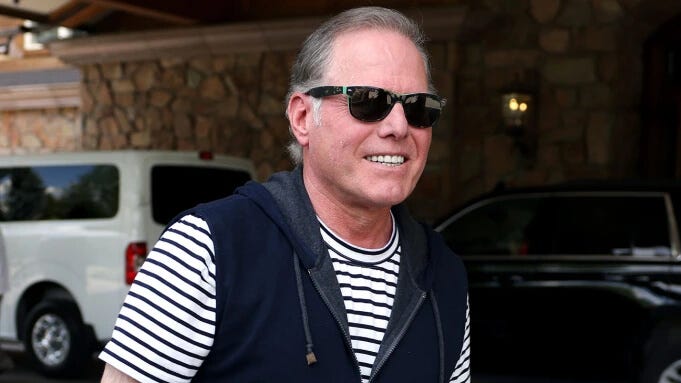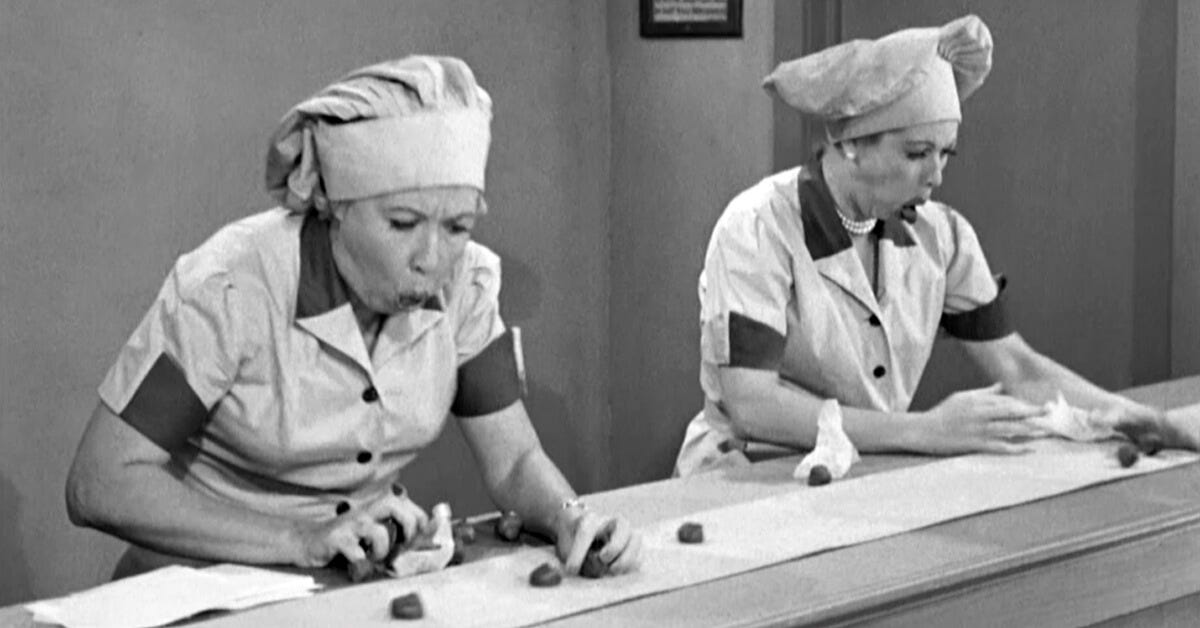Warner Bros. Discovery, See's Candies, and Berkshire Hathaway
Happy Monday!
🔥 Charlie Munger out there spitting fire:
“You can argue that if you’re not willing to react with equanimity to a market price decline of 50% two or three times a century, you’re not fit to be a common shareholder and you deserve the mediocre results you’re going to get compared to people who do not have this temperament and can be more philosophical about these market fluctuations.”
Keeping a calm head amidst market panic is the name of the game. Just look at how jangled Wall Street’s nerves are after a moderate fall in the S&P 500 (-14% this year) and the Nasdaq turning bearish. Now imagine what it would be like if the market fell 50%, as Munger notes above.
Total bedlam.
Make sure you have the right temperament before you start to play the money game.
Warner Bros. Discovery 📺🎬🎮
The new kid on the streaming block has a rather complicated origin story. Back in 2018, AT&T shelled out $85 billion to acquire Time-Warner in an ill-advised attempt to vertically integrate entertainment content with the company’s bread-and-butter phone/network business.
It didn’t work out.
Skeptical shareholders never really warmed up to the idea and AT&T stock sank like a stone. So, in a last ditch effort to unlock some value from WarnerMedia (and appease Wall Street), AT&T announced that it would spin off its entertainment assets and then merge them with Discovery to form a new, improved media powerhouse.
And, while WarnerMedia hung like a millstone around the neck of AT&T, that’s no reflection on Warner itself. The Hollywood blue blood boasts an incredible library of content and intellectual property — including HBO, CNN, Warner Bros. film studio, TNT, TBS, HGTV, Food Network, DC Comics, and more.
Starting fresh. Warner Bros. Discovery, as the new entity has been so creatively named, officially opened for business on April 8, 2022, with David Zaslav as CEO. In some of his first comments after the merger, Zaslav pledged to join HBO Max (the WarnerMedia streamer) with Discovery+ to form a larger, combined streaming service capable of standing toe-to-toe with Disney, Netflix, and Paramount.
And, while I’m all for consolidating the bafflingly large number of streaming services out there, HBO Max and Discovery+ seem a very odd fit.
HBO is pure prestige. Discovery? Not so much.
But Zaslav insists there’s a method to his madness. “Our research shows that people who watch [HBO’s] Euphoria, their second favorite show is [TLC’s] 90-Day Fiancé.”
So I stand corrected.
Battling bloat. Warner Bros. Discovery was born into the world saddled with debt. $55 billion of it, to be exact. AT&T didn’t miss the chance to slough off some of its immense debt burden onto the newly spun-off/merged entity.
So that’s not ideal for WBD — but it does imbue the company with a healthy fear of the spiraling content costs that have recently plagued the streaming industry. Simply put, Warner Bros. Discovery can’t afford to be loose with cash.
“We are not trying to win the direct-to-consumer (streaming) spending war,” says Zaslav.
To prove his point, Zaslav chopped scripted original programming at TBS and TNT — to be replaced by cheaper, unscripted (read: reality) shows.
And that’s where the Discovery side of this Frankenstein’s monster comes in. Discovery+ is pretty much unscripted central. It’s not all trashy — there’s an Anthony Bourdain: No Reservations for every Married At First Sight — but it’s hardly awards bait, either.
What it is, is cheap. Much more so than scripted series and movies.
For example, episodes of the upcoming Game of Thrones prequel, House of the Dragon, will cost HBO nearly $20 million a piece. Reality fare, on the other hand, typically costs around $200,000 to $300,000 per episode. Big difference.
Zaslav’s quest to keep a tight rein on costs, though, won’t be easy. Even with the prodigious Discovery+ unscripted library in hand. “There is a lot of bloat in budgets,” says John Ford, former president of Discovery Channel, “but I don’t know if it’s bloat you can cut out. Hollywood runs on that bloat.”
🚫 Netflix. Like pretty much everyone else in the streaming space, Warner Bros. Discovery wants to make it very clear that it’s not just another Netflix.
“We have the ability to ring any number of cash registers,” Zaslav points out.
In other words, we’re not a legacy streamer solely reliant on subscription revenue.
Those cash registers include cable and satellite television, feature films, video games, as well as both ad-supported and premium subs-based streaming. Multiple revenue streams seem to be the most effective counterpoint to Wall Street’s newfound concern about the future of streaming and how much that future will cost.
(This is basically the same case I keep making for Paramount…)
If all of a streamer’s eggs are in one basket — *cough* Netflix *cough* — content costs become a big problem. But, at least in theory, Warner Bros. Discovery should have enough cash rolling in from diversified sources to more than offset the expense of building up a subscription base and keeping the service populated with content.
That’s Zaslav’s argument, anyway.
AT&T exodus. Warner Bros. Discovery stock hasn’t done very well since the merger. Of course, the same could be said for plenty of others, too.
In WBD’s case, though, the downward price pressure has a pretty good explanation. AT&T shareholders — who invested in the company for its stable dividend (lol), juggernaut phone business, and conservative growth profile — received 71% of Warner Bros. Discovery shares post-merger.
A new, somewhat risky streaming venture isn’t what they signed up for — so they’re understandably heading for the exits. Heavy selling from the fleeing AT&Ters is a heck of a (temporary) headwind for WBD.
But it won’t last forever.
Insider buying. I’ve heard it said that people sell stocks for a million different reasons, but they only buy for one: they expect the stock to go up.
So, with that in mind, I’m happy to report that several Warner Bros. Discovery execs bought the dip in WBD back in April.
Among the bullish insiders:
CEO David Zaslav bought 50,000 shares for $1 million, which raises his overall stake to 4.1 million shares.
Geoffrey Yang, a company director, added $1 million worth of WBD.
CFO Gunnar Wiedenfels purchased $500,000 worth of WBD.
These aren’t huge numbers. I get that.
But it still seems like those that know Warner Bros. Discovery best believe that it’s underpriced sub-$20. And they’re probably right.
Me? I’m waiting for at least a few post-merger earnings reports before making any decision one way or the other.
One closing note: While most consider insider buying to be a good sign, it’s hardly a fool-proof guarantor of an impending turnaround. Netflix CEO Reed Hastings bought $20 billion of NFLX shares after the company’s first big fall in January and that’s not looking so hot right about now…
See’s Candies 🍫🍬🍭
In 1972/73, Berkshire Hathaway (through Blue Chip Stamps) bought See’s Candies for $35 million. This somewhat pricy purchase is often credited as the moment that Charlie Munger finally convinced Warren Buffett to stop chasing cigar butts and focus instead on excellent brand names.
But, while See’s certainly cost more than Buffett wanted to pay, the $35 million purchase price is a little misleading. The candy company held about $10 million of cash on its balance sheet — which effectively reduced the price to $25 million.
Whatever concerns Buffett had over the price, though, were short-lived. See’s proved to be a bargain from the jump. Operating profit grew from $2.1 million in 1972 to $11.9 million a decade later.
And, since See’s needed very little capital to keep the lights on, the vast majority of that profit could be sent to Buffett and Munger for reinvestment elsewhere. Many of Berkshire’s (and Blue Chip’s) most famous acquisitions were only possible due to the torrents of cash gushing out of See’s Candies.
So how did See’s do it?
The California-based candy maker never — and I mean never — compromised on the quality of its creations. Even during World War II, when the United States rationed key supplies like sugar and butter, See’s did not bend. The company refused to switch to inferior (but readily available) ingredients like some of its competitors.
Instead, See’s decided to make what candy it could from the rationed supplies and, once it sold out, that store closed for the day. One shop actually posted this note at the height of the holiday shopping rush: “Sold Out. Fresh Candies Dec. 27th. Give War Bonds for Christmas.”
It’s that kind of dedication — in the face of war, no less — that has kept See’s at the top of the candy game for so long. It’s also the reason that See’s can raise prices every year without losing customers.
As Buffett once quipped, a man can’t go home on Valentine’s Day and tell his wife that he took the low bid on her box of chocolates.
Berkshire Hathaway
Some odds and ends out of Omaha:
I’d be remiss to write about See’s Candies and not mention the Berkshire subsidiary’s brush with Hollywood immortality. While preparing for the “Job Switching” episode of I Love Lucy, Lucille Ball and Vivian Vance visited the See’s workshop in Culver City to practice making, rolling, and wrapping candy. The resulting scene, with Lucy and Ethel haplessly losing their battle against the chocolate factory’s conveyor belt, remains an iconic part of television history. TV Guide once called it I Love Lucy’s “chaotic, crowning moment”.
This week, Hewlett-Packard CEO Enrique Lores broke his silence on Berkshire’s $4.2 billion investment in his company. “Having one of the most respected investors as one of the investors in HP is a great sign of confidence for all of us.” Lores went on to say, “I learned that he’s a happy customer of an HP PC. He uses our products and this is another incentive for us to continue to drive that business forward.” On an unrelated note, Tim Cook just shipped off a pallet full of iMacs to Omaha.
Citigroup CEO Jane Fraser also spoke about Berkshire’s recent $3 billion investment in her bank. “I was delighted to have a conversation with Mr. Buffett. Who wouldn’t enjoy that phone call?” She continued, “He’s a wonderful investor, we’re delighted to have him in, and we hope there will be more investors who will be following in his footsteps as our team delivers progress. We’ve always said the proof will be in the pudding — and we’re delivering the pudding.”
How did Berkshire end up with GEICO? Warren Buffett goes way back with the auto insurer, both personally and through his partnership, but Berkshire itself didn’t invest until the mid-1970s. Through 1973, GEICO had recorded 28 straight years of underwriting profits. But, then, losses started to pile up and the share price fell from $58.88 (in ‘73) to $2.13 (in ‘76). That’s a 96% drop. Penthouse to outhouse in the blink of an eye. Buffett and Berkshire pounced, gobbled up every common and preferred share they could, and the rest is history.
If you enjoy my work, please hit the ❤️ below and share this post with anyone who might be interested (or on social media). Thank you!
Disclosure: This is not financial advice. I am not a financial advisor. Do your own research before making any investment decisions.



